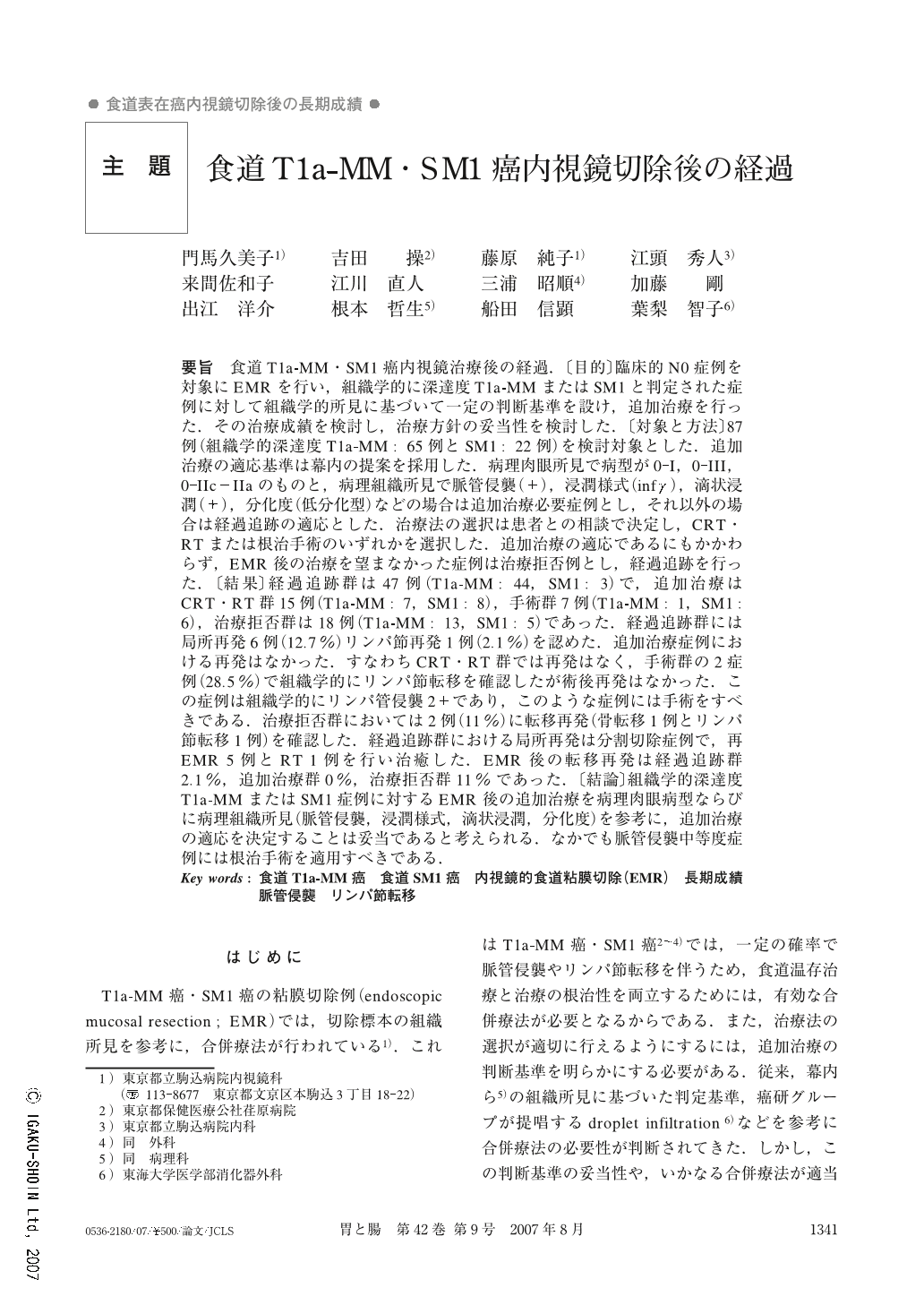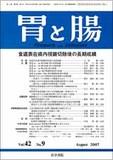Japanese
English
- 有料閲覧
- Abstract 文献概要
- 1ページ目 Look Inside
- 参考文献 Reference
- サイト内被引用 Cited by
要旨 食道T1a-MM・SM1癌内視鏡治療後の経過.〔目的〕臨床的N0症例を対象にEMRを行い,組織学的に深達度T1a-MMまたはSM1と判定された症例に対して組織学的所見に基づいて一定の判断基準を設け,追加治療を行った.その治療成績を検討し,治療方針の妥当性を検討した.〔対象と方法〕87例(組織学的深達度T1a-MM:65例とSM1:22例)を検討対象とした.追加治療の適応基準は幕内の提案を採用した.病理肉眼所見で病型が0-I,0-III,0-IIc+IIaのものと,病理組織所見で脈管侵襲(+),浸潤様式(infγ),滴状浸潤(+),分化度(低分化型)などの場合は追加治療必要症例とし,それ以外の場合は経過追跡の適応とした.治療法の選択は患者との相談で決定し,CRT・RTまたは根治手術のいずれかを選択した.追加治療の適応であるにもかかわらず,EMR後の治療を望まなかった症例は治療拒否例とし,経過追跡を行った.〔結果〕経過追跡群は47例(T1a-MM:44,SM1:3)で,追加治療はCRT・RT群15例(T1a-MM:7,SM1:8),手術群7例(T1a-MM:1,SM1:6),治療拒否群は18例(T1a-MM:13,SM1:5)であった.経過追跡群には局所再発6例(12.7%)リンパ節再発1例(2.1%)を認めた.追加治療症例における再発はなかった.すなわちCRT・RT群では再発はなく,手術群の2症例(28.5%)で組織学的にリンパ節転移を確認したが術後再発はなかった.この症例は組織学的にリンパ管侵襲2+であり,このような症例には手術をすべきである.治療拒否群においては2例(11%)に転移再発(骨転移1例とリンパ節転移1例)を確認した.経過追跡群における局所再発は分割切除症例で,再EMR 5例とRT 1例を行い治癒した.EMR後の転移再発は経過追跡群2.1%,追加治療群0%,治療拒否群11%であった.〔結論〕組織学的深達度T1a-MMまたはSM1症例に対するEMR後の追加治療を病理肉眼病型ならびに病理組織所見(脈管侵襲,浸潤様式,滴状浸潤,分化度)を参考に,追加治療の適応を決定することは妥当であると考えられる.なかでも脈管侵襲中等度症例には根治手術を適用すべきである.
Lymph node metastasis is noted in about 10%of all T1a-MM and SM1 cases of esophageal cancer. There fore, some of them need additional treatments after endoscopic mucosal resection〔EMR〕. We have to find a standard which allows us to recommend additional treatment following EMR.
〔Aim〕Clinical results of our patients who underwent EMR for surperficial esophageal cancer and with invasion of T1a-MM (cancer invasion reaching to the muscularis mucosae) and SM1 (cancer invasion into the submucosa less than 200 micro meters) were analyzed to find the effects of additional treatments.
〔Subject and Method〕Eighty seven patients who had no lymph node metastasis in clinical examinations before EMR and histological studies on resected specimens, but revealed cancer invasion of T1a-MM or SM1 were included in this study. Additional treatments such as chemoradiotherapy (CRT: CDDP+5FU with irradiation 50 to 60 Gy) or radiotherapy (RT: group B), radical esophagectomy (group C) were indicated when the cancer lesion was classified into type 0-I, 0-III or type 0-IIa+IIc, or had histological findings such as microvascular permeation, diffuse infiltration, the so called"droplet infiltration"and undifferentiated cancer cells in the margin of the tumor. Patients without such findings underwent clinical observation (group A). Mode and incidence of recurrence in each group was studied.
〔Results〕Fourty seven patients underwent clinical follow up (the group A 47 cases: T1a-MM 44 and SM1 3), 15 CRT・RT (the group B 15 cases: T1a-MM 7 and SM1 8), 7 esophagectomy (the group C 7 cases: T1a-MM 1 and SM1 6) and 18 with indication for additional treatment were observed, after they refused any additional treatment (the group D 18 cases: T1a-MM 13 and SM1 5). Local recurrence was noted in 12.7%of group A and lymph node metastasis in 2.1%. All local recurrence was successfully treated by EMR (5 cases) and irradiation (1 case). There was no recurrence among group B and group C, while the histological studies on resected specimens revealed lymph node metastases in two patients of group C. Two patients (11%) of group D presented recurrence (bone metastasis 1 case and lymph node metastasis 1 case) after EMR. Incidence of life threatening recurrence after EMR was significantly high in the group D (11%) while it was very low in the group A (2.1%), in the group B (0%) and the group C (0%).
〔Conclusion〕The present indication for additional treatment following EMR on T1a-MM and SM1 esophageal cancer is acceptable.

Copyright © 2007, Igaku-Shoin Ltd. All rights reserved.


